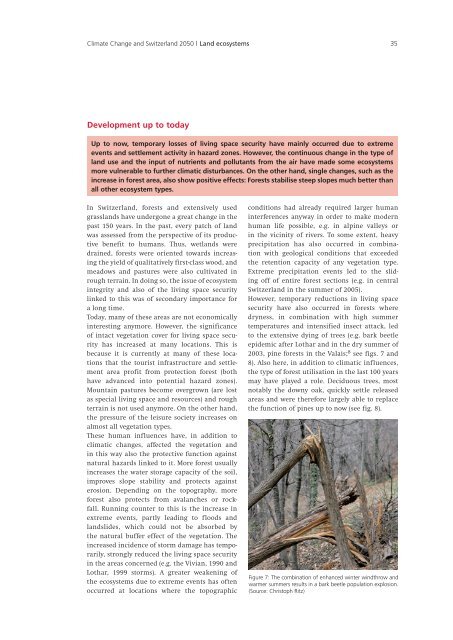Climate Change and Switzerland 2050 - OcCC - SCNAT
Climate Change and Switzerland 2050 - OcCC - SCNAT
Climate Change and Switzerland 2050 - OcCC - SCNAT
You also want an ePaper? Increase the reach of your titles
YUMPU automatically turns print PDFs into web optimized ePapers that Google loves.
<strong>Climate</strong> <strong>Change</strong> <strong>and</strong> Switzerl<strong>and</strong> <strong>2050</strong> | L<strong>and</strong> ecosystems 35<br />
Development up to today<br />
Up to now, temporary losses of living space security have mainly occurred due to extreme<br />
events <strong>and</strong> settlement activity in hazard zones. However, the continuous change in the type of<br />
l<strong>and</strong> use <strong>and</strong> the input of nutrients <strong>and</strong> pollutants from the air have made some ecosystems<br />
more vulnerable to further climatic disturbances. On the other h<strong>and</strong>, single changes, such as the<br />
increase in forest area, also show positive effects: Forests stabilise steep slopes much better than<br />
all other ecosystem types.<br />
In Switzerl<strong>and</strong>, forests <strong>and</strong> extensively used<br />
grassl<strong>and</strong>s have undergone a great change in the<br />
past 150 years. In the past, every patch of l<strong>and</strong><br />
was assessed from the perspective of its productive<br />
benefit to humans. Thus, wetl<strong>and</strong>s were<br />
drained, forests were oriented towards increasing<br />
the yield of qualitatively first-class wood, <strong>and</strong><br />
meadows <strong>and</strong> pastures were also cultivated in<br />
rough terrain. In doing so, the issue of ecosystem<br />
integrity <strong>and</strong> also of the living space security<br />
linked to this was of secondary importance for<br />
a long time.<br />
Today, many of these areas are not economically<br />
interesting anymore. However, the significance<br />
of intact vegetation cover for living space security<br />
has increased at many locations. This is<br />
because it is currently at many of these locations<br />
that the tourist infrastructure <strong>and</strong> settlement<br />
area profit from protection forest (both<br />
have advanced into potential hazard zones).<br />
Mountain pastures become overgrown (are lost<br />
as special living space <strong>and</strong> resources) <strong>and</strong> rough<br />
terrain is not used anymore. On the other h<strong>and</strong>,<br />
the pressure of the leisure society increases on<br />
almost all vegetation types.<br />
These human influences have, in addition to<br />
climatic changes, affected the vegetation <strong>and</strong><br />
in this way also the protective function against<br />
natural hazards linked to it. More forest usually<br />
increases the water storage capacity of the soil,<br />
improves slope stability <strong>and</strong> protects against<br />
erosion. Depending on the topography, more<br />
forest also protects from avalanches or rockfall.<br />
Running counter to this is the increase in<br />
extreme events, partly leading to floods <strong>and</strong><br />
l<strong>and</strong>slides, which could not be absorbed by<br />
the natural buffer effect of the vegetation. The<br />
increased incidence of storm damage has temporarily,<br />
strongly reduced the living space security<br />
in the areas concerned (e.g. the Vivian, 1990 <strong>and</strong><br />
Lothar, 1999 storms). A greater weakening of<br />
the ecosystems due to extreme events has often<br />
occurred at locations where the topographic<br />
conditions had already required larger human<br />
interferences anyway in order to make modern<br />
human life possible, e.g. in alpine valleys or<br />
in the vicinity of rivers. To some extent, heavy<br />
precipitation has also occurred in combination<br />
with geological conditions that exceeded<br />
the retention capacity of any vegetation type.<br />
Extreme precipitation events led to the sliding<br />
off of entire forest sections (e.g. in central<br />
Switzerl<strong>and</strong> in the summer of 2005).<br />
However, temporary reductions in living space<br />
security have also occurred in forests where<br />
dryness, in combination with high summer<br />
temperatures <strong>and</strong> intensified insect attack, led<br />
to the extensive dying of trees (e.g. bark beetle<br />
epidemic after Lothar <strong>and</strong> in the dry summer of<br />
2003, pine forests in the Valais; 8 see figs. 7 <strong>and</strong><br />
8). Also here, in addition to climatic influences,<br />
the type of forest utilisation in the last 100 years<br />
may have played a role. Deciduous trees, most<br />
notably the downy oak, quickly settle released<br />
areas <strong>and</strong> were therefore largely able to replace<br />
the function of pines up to now (see fig. 8).<br />
Figure 7: The combination of enhanced winter windthrow <strong>and</strong><br />
warmer summers results in a bark beetle population explosion.<br />
(Source: Christoph Ritz)

















